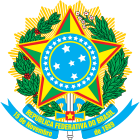This article has multiple issues. Please help improve it or discuss these issues on the talk page. (Learn how and when to remove these messages)
|
| This article is part of a series on the |
 |
|---|
Brazil has a multi-party system since 1979, when the country's military dictatorship disbanded an enforced two-party system and allowed the creation of multiple parties.[1]
Above the broad range of political parties in Brazilian Congress, the Workers' Party (PT), the Brazilian Democratic Movement (MDB), the Liberal Party (PL), the Progressives (PP) and the Brazil Union (UNIÃO) together control the absolute majority of seats in the Senate and Chamber of Deputies.[2] Smaller parties often make alliances with at least one of these five major parties.[3] The number of political parties reached the apex of 35 on 2018, 30 of which were represented in congress after the 2018 general election.[4][5][6] However, an electoral threshold introduced on 2017 has resulted in the culling and merger of many parties, as it cuts access to party subsidies and free party political broadcasts.[4][7]
Brazilian parties have access to party subsidies in form of the Fundo Partidário (lit. 'Party Fund') and the Fundo Eleitoral (lit. 'Electoral Fund') for elections.[8] And a system of free party political broadcasts during election time known as the horário eleitoral gratuito.[9]
Since 1982, Brazilian political parties have been given an electoral number to make it easier for illiterate people to vote. Initially, it was a one-digit number: 1 for PDS, 2 for PDT, 3 for PT, 4 for PTB, and 5 for PMDB. When it became clear that there was going to be more than nine parties, two-digit numbers were assigned, with the first five parties having a "1" added to their former one-digit number (PDS becoming number 11, PDT 12, PT 13, PTB 14, and PMDB 15). Political parties often change their names, but they can retain their number.
In terms of association, parties can form electoral coalitions and party federations. Since 2017, coalitions are only allowed in elections under the majority system. Therefore, political parties can unite in support for a presidential or senatorial candidate, for example. However, parties cannot form coalitions for the election of federal deputies, state deputies and councillors.[10] Coalitions are formed before the elections and do not oblige parties to remain together afterwards.[11] Party federations, on the other hand, are legally different from coalitions in that they are longer-lasting, have a national scope and require ideological unity. Unlike coalitions, the parties that make up a federation are treated as a single party in legislative activity and in elections; they are prohibited from acting independently in the legislative houses or from filing election-related lawsuits, as the federation has the sole legal standing to do so.[12]
- ^ Sousa, Ana Cristina Augusto de; Silva, Lays Correa da (6 August 2021). "Redemocratização no Brasil: continuidade ou ruptura?". Topoi (Rio de Janeiro) (in Portuguese). 22 (47): 570–575. doi:10.1590/2237-101X02204713. ISSN 1518-3319. S2CID 238849517.
- ^ Freedom House report on Brazil, 2007
- ^ "Estatísticas do eleitorado – Eleitores filiados". tse.jus.br (in Brazilian Portuguese). Archived from the original on 9 May 2019. Retrieved 3 June 2020.
- ^ a b "Número de partidos na Câmara deve cair após ápice da fragmentação em 2018". Poder360 (in Brazilian Portuguese). 24 February 2021. Retrieved 16 October 2022.
- ^ "Brasil tem 75 partidos políticos em processo de formação".[permanent dead link]
- ^ "Brasil vai às urnas em outubro com 35 partidos". Senado Federal (in Brazilian Portuguese). Retrieved 16 October 2022.
- ^ "Perspectiva é de fusão entre partidos". Valor Econômico (in Brazilian Portuguese). 4 October 2022. Retrieved 16 October 2022.
- ^ Fundo Partidário (estudo) Archived 2014-11-29 at the Wayback Machine. Por Miriam Campelo de Melo Amorim. Brasília: Biblioteca Digital da Câmara dos Deputados, outubro de 2005.
- ^ "L9504". www.planalto.gov.br. Retrieved 16 October 2022.
- ^ Emenda Constitucional nº 97. www.planalto.gov.br. Retrieved 18 September 2024.
- ^ "Das Coligações". TRE-PI (in Portuguese). Retrieved 19 September 2024.
- ^ Barros, Ezikelly (4 August 2022). "Partidos federados não podem atuar isoladamente desde o registro no TSE". Consultor Jurídico (in Portuguese). Retrieved 19 September 2024.